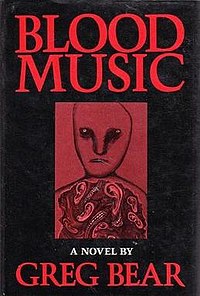Blood Music
by Greg Bear
In the novel, renegade biotechnologist Vergil Ulam creates simple biological computers based on his own lymphocytes. Faced with orders from his nervous employer to destroy his work, he injects them into his own body, intending to smuggle the "noocytes" (as he calls them) out of the company and work on them elsewhere. Inside Ulam's body, the noocytes multiply and evolve rapidly, altering their own genetic material and quickly becoming self-aware. The nanoscale civilization they construct soon begins to transform Ulam, then others. The people who are infected start to find that genetic faults such as myopia and high blood pressure get fixed. Ulam's eyesight, posture, strength, and intelligence are all improved. The infected can even have conversations with their noocytes, some reporting that the cells seem to sing.
Through infection, conversion, and assimilation of humans and other organisms, the cells eventually aggregate most of the biosphere of North America into a region seven thousand kilometers wide. This civilization, which incorporates both the evolved noocytes and recently assimilated conventional humans, is eventually forced to abandon the normal plane of existence in favor of one in which thought does not require a physical substrate. The reason for the noocytes' inability to remain in this reality is somewhat related to the strong anthropic principle.
The book's structure is titled "inter-phase", "prophase", "metaphase", "anaphase", "telophase", and "interphase". This mirrors the major phases of cell cycle: interphase and mitosis.
